5 Epic Hikes in Indonesia

It was practically the middle of the night when the alarm went off and I willed myself to get out bed. The driver pulled up to our Ubud villa on time—3:30 a.m. on the dot—to drive my boyfriend and I to Mount Batur, where we would do the popular trek to the summit for sunrise.
On the steep, rocky ascent, I questioned our decision. We live in Boulder, Colorado, where we can hike any number of amazing mountain trails any time we want. Why, while we were in Bali—land of beautiful beaches, monkey-filled rainforests, and some of the most stunning spiritual temples imaginable—were we huffing, puffing, and sweating our way more than 5,000 feet above sea level?
We got to the top and waited for the sun to come up, sweat-soaked and chilled. And just as I started questioning our choice again, the bright red sun started to peek up through the clouds and the sky started changing colors—first a pinkish-red hue, then purple, then orange. We sat in silence, simply taking in the sights around us as they started to light up with the sunrise: Mount Rinjanji, the second tallest mountain and another active volcano, in the distance; the pristine Lake Batur below us; monkeys climbing and playing on the mountain ledge beside us. In that moment, I felt like I was in a different kind of temple, grateful to be connecting to this place—and myself—in a new, beautiful way.
While it can be tempting to stick to the most popular tourist attractions when you visit Bali (think: rice paddies, waterfalls, beaches, and temples), there are a number of epic hikes that’ll give you a different vantage point, and an incredibly moving—possibly even spiritual— experience. Here are five treks to consider:
Mount Batur
One of Bali’s most prominent volcanoes, Mount Batur may be its prettiest: It’s nestled between two concentric craters, bordered by Lake Batur, and offers spectacular views of another volcano—Mount Rinjanji—in the distance. As a result, this 5-kilometer (3.1 mile) roundtrip hike is famous for its views from the top at sunrise, which means you’ll start walking up the rocky ascent before 6 a.m. and make the mile-high climb to the top (the peak is about 5,600 feet/1,707 meters above sea level) just before the sun splatters an outburst of purples, pinks, and reds across the sky. Bonus: The Batur Natural Hot Springs are just a 15-minute drive from the trailhead and perfect for a post-hike soak.
Know before you go: You’ll be required to hire a guide to walk with you to the top, which will cost you around $20 per person. Also, it gets chilly at the top, so be sure to pack layers in a lightweight backpack.
Mount Agung
Bali is just one of the 17,000 islands that make up the Indonesian archipelago, but it’s called the “Island of the Gods,” and is considered by many to be the holiest. And Mount Agung is the island’s highest—and holiest—volcano. The ascent of this mountain isn’t for the unfit—or faint of heart. You’ve got two choices when it comes to your trek up: The Pura Besakih route is a steep climb that takes about six hours to reach the summit and five hours to get back down, which means you’ll want to start this hike around midnight so you can be at the top when the sunrise begins; the shorter, three to four hour Pura Pasar Agung route takes you along the lower edge of the crater rim and offers great views of the eastern and southern part of Bali.
Know before you go: The best time to hike Mount Agung is from July until September, and it’s prohibited to go hiking during religious events. (And don’t even think about ignoring this rule; not only is it disrespectful, but the Balinese believe the gods will punish you if you do.)
Campuhan Ridge Walk
Looking for something a little less strenuous? This easy (and free, since there’s no need to hire a guide) trek takes you through some of the most beautiful countryside in Ubud. You’ll start by crossing a small bridge over the Campuhan River, which leads you to the Pura Ganung Lebah temple complex. The trail takes you along the intricately carved walls of the temple, through lush valleys, and even into the rice paddies of the small village of Bangkiang Sidem.
Know before you go: Walk this trail in the early morning or late afternoon, when the temperature is cool and the lighting is ideal for capturing pics of the rolling green hills and backdrop of Mount Agung. And keep your phone or camera handy in a lightweight waist pack, since you’ll want to take lots of photos.
Manduk Jungle
Looking for an area with lots of hiking options? From an easy, two-hour hike to the Red Coral Waterfall to the more difficult “Tropical Fruit” trek, you’ll find a trail for everyone in Manduk—and your efforts will be rewarded with views of rainforests, rice paddies, hidden temples, waterfalls, and more. Insider tip: Treat yourself to a cup of Luwak coffee, some of the world’s finest and most expensive, on your way there or back.
Know before you go: Like most hiking in Bali, you’ll want to hire a guide (which will cost about $25 for two to three hours) so you don’t get lost.
Mount Rinjanji, Lombok
Although this hike isn’t technically on the island of Bali, Lombok island is close and easily accessible from Bali—and this trek up the second tallest mountain in Indonesia and an active volcano is a must for serious hikers. Unlike the other hikes, this one takes three days and four nights, which means you’ll want to pack plenty of layers, a head lamp, and possibly even walking sticks in your international carry-on. You’ll trek through rainforests, camp on the crater rim, and catch stunning views of the nearby Gili islands and Mount Agung rising above Bali; you’ll pass an aquamarine lake in the crater, as well as natural hot springs perfect for soaking tired muscles. While the third day’s hike to the summit of this volcano will be the most challenging, the views from the top will also make it the most rewarding.
Know before you go: Consider buying a tour package, which includes a guide as well as a night at a hotel near the trailhead, for about $180.
While Eagle Creek is here to provide tips and insights on travel, we cannot accept any responsibility for any potential consequences arising from the use of this information. Always conduct your own research and use your best judgment.
Related Links (from the Eagle Creek blog):
Off the Beaten Path: Trekking in South India





































